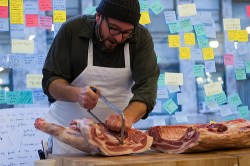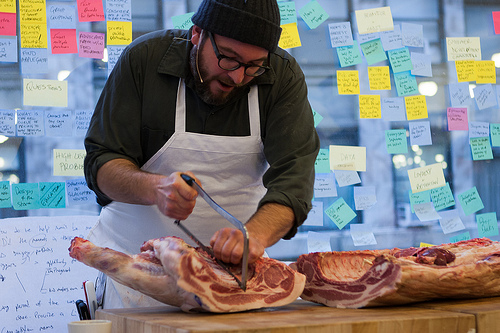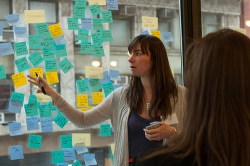The meat industry in this country has room for major improvement. As we’ve pointed out before, very few companies control the vast majority of the market. Big producers rely on CAFOs, where they feed the animals huge quantities of antibiotics to produce lots of cheap meat. Meanwhile, small ranchers and producers are often working with no support, and very little technology, while most consumers tend to see sustainably produced meat as a boutique option (and with prices hovering around five times that of conventional meat, how can we blame them?).
Enter Hack//Meat. Last week’s hackathon was much like events that allow tech industry experts to put their heads together in a concerted way to, say, develop a piece of software collaboratively. Only this one was focused on improving the meat industry. For 48 hours, a group of food movement leaders, entrepreneurs, and software developers met to tackle some of the most pressing issues faced by the sustainable meat industry. This is the third such event convened by Food+Tech Connect (it was also sponsored by the GRACE Communication Foundation and the Applegate company).
As Food+Tech Connect founder Danielle Gould sees it, hacking is a necessary approach to today’s food landscape. As she writes on her site, “Like the first few generations of computer software and hardware industries, food and agriculture are highly proprietary, consolidated industries. And just as the hacking community seeks to understand how a technology works, people are increasingly looking to know [by whom] and how their food is produced.”

The hackathon also included some literal hacking — a pig-butchering demo with Tom Mylan.
Food+Tech Connect worked with nonprofit groups like Food and Water Watch and the Consumers Union to devise a series of challenges related to issues such as local meat distribution, slaughter, food labels, and antibiotic use. Food system experts then teamed up with software developers and other tech experts to generate ideas for solutions.
The winning idea was something called Carv, “an internet-enabled scale and label printer that captures and manages data about individual cuts of meat, which can be converted into reports and invoices for anyone in the value chain, including USDA and FSIS [Food Safety Inspection Service].”
Sisters Melkorka and Ulla Kjarval — whose parents own Spring Lake Farm, a grass-fed beef and pastured lamb and pork business in upstate New York — were key participants in the winning team, which examined ways that “technology could help the local meat value chain to scale up and become economically sustainable by facilitating further integration between farmers, processors and consumers.”
The Kjarval sisters help market their parents’ meat through a New York City-based buying club, and maintain the website, while running a small design and photography business. (The family is originally from Iceland, thus the super-cool names.) “Like members of a lot of farm families, we work for the farm but don’t expect to make money,” Ulla Kjarval told me recently.
The Kjarvals have seen, firsthand, how tricky it can be for their parents to keep track of data about the cuts of meat they produce and sell. So when a software developer on their team proposed the idea of a scale that also collected data, it sounded like a great fit. The team will receive $2,500 and strategy consulting.
“I’m excited to be involved in a tool that will make it easier for people who are already doing this important work,” said Melkorka Kjarval.
The other winners included an Open Table-like tool for small farmers to help them schedule times to slaughter animals (it allows farmers and ranchers to search for specific meat processors by location) and a Foursquare application called Meat that promises to “match consumer demand with grocery store supply by allowing consumers to request specific products” and let their friends know what they’re buying and when.
Paul Matteucci, a Silicon Valley-based investor and the founder of Feeding 10 Billion, a nonprofit to help food system entrepreneurs, was one of several judges at the hackathon. Matteucci has been to many of these quick, high-intensity events, but they’re usually focused on technology, data, and security. “This was my first meat one,” he said.
Matteucci was drawn to the Carv project because of the transparency the tool would provide — a quality he says is sorely lacking in today’s meat industry.
“The idea that you can tag an animal at the time it enters the food system, and follow it until its parts leave the system means not only can you mitigate waste, but you can also work backwards if you have a [food safety] problem at the other end.” All of that is almost impossible now, he adds. “We’ve all read stories about how one hamburger may contain the meat of 100 different cows.”

The investor clearly has a profit motive (he sees protein production as a major area for investment), but he also has a serious interest in helping small producers.
“Information technology really has ignored agriculture and food distribution,” he says. “The big companies have their own in-house [technology] systems, but there aren’t systems for the myriad of little companies that are trying to be more efficient in order to compete,” he says.
Hopefully the tools developed last weekend will bring the alternative face of the industry — and farmers like the Kjarvals — one step closer to that goal.
See more photos of Hack//Meat.




